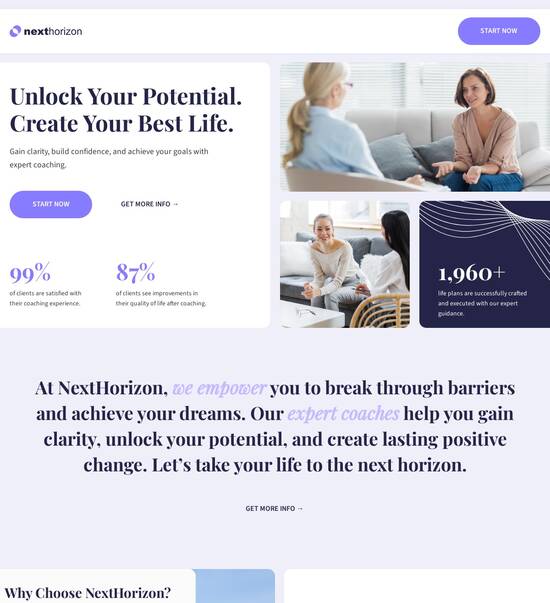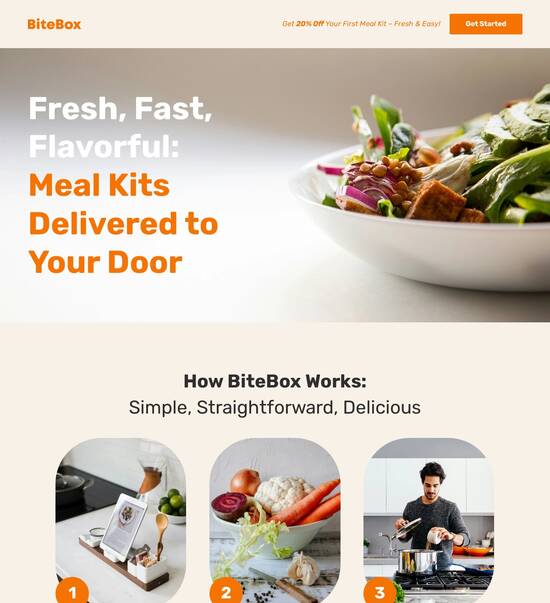
HTML page template for Virtual assistants
Use TemplateAbout template
Attract clients and showcase your skills with style using our landing page templates for Virtual assistants. Let's convert those visitors into clients!
Recommended templates

Easy to build without coding
With the intuitive drag-and-drop builder, anyone on your team can create high-converting pages without any knowledge of code or design. Make enhancements to your landing page with custom widgets using Javascript, HTML/CSS, or third-party scripts.

Multiple layouts for any industry and goal
Select from 500+ landing page layouts built to boost conversions across industry-specific scenarios. Customize them by adjusting fonts, adding images, and generating on-brand content with the AI assistant. Quickly scale with Instablocks® and Global Blocks that you can save, reuse, and update globally.

Loads fast and looks polished on any device
Every template is responsive, which means they present professionally on any device and load blazingly fast with our Thor Render Engine. You can also power them up with Google AMP technology to deliver an unparalleled mobile experience and drive higher conversions.

Robust analytics & experimentation
Get real-time updates and reporting across all your devices, showing the number of visitors, conversions, cost-per-visitor, and cost-per-lead. Launch AI-powered experiments, run A/B tests, and use heatmaps to analyze user behavior, then optimize your landing page to maximize conversions.







Easy to build without coding
With the intuitive drag-and-drop builder, anyone on your team can create high-converting pages without any knowledge of code or design. Make enhancements to your landing page with custom widgets using Javascript, HTML/CSS, or third-party scripts.
Multiple layouts for any industry and goal
Select from 500+ landing page layouts built to boost conversions across industry-specific scenarios. Customize them by adjusting fonts, adding images, and generating on-brand content with the AI assistant. Quickly scale with Instablocks® and Global Blocks that you can save, reuse, and update globally.
Loads fast and looks polished on any device
Every template is responsive, which means they present professionally on any device and load blazingly fast with our Thor Render Engine.
Robust analytics & experimentation
Get real-time updates and reporting across all your devices, showing the number of visitors, conversions, cost-per-visitor, and cost-per-lead. Launch AI-powered experiments, run A/B tests, and use heatmaps to analyze user behavior, then optimize your landing page to maximize conversions.
All the features you need to build virtual assistant websites templates
Explore more featuresLearn how to build free virtual assistant website templates
Frequently asked questions about virtual assistant template
Leading the way in building high-performing landing pages





Templates for virtual assistant websites: Your ultimate how-to guide
In today's digital marketing landscape, having a robust landing page is crucial for capturing leads and maximizing ROI. Instapage equips marketers with the most powerful tools to create high-converting landing pages that drive results for various sectors, including Business Services, Education, and Tech/SaaS. This guide will walk you through the step-by-step process of utilizing Instapage to launch successful campaigns.
Understanding landing pages on Instapage
Landing pages are specialized web pages designed to focus on a single objective, often leading visitors toward taking a specific action, such as signing up or making a purchase. Instapage offers flexibility and ease of use, allowing you to build landing pages that convert without needing developer support. With over 100 conversion-focused templates and intuitive design features, you can create beautiful pages that resonate with your target audience.
- Customization: Tailor your landing pages with drag-and-drop functionality to meet your brand's needs.
- High-converting templates: Choose from over 100 ready-to-use templates that are optimized for conversion.
- Integration: Seamlessly integrate with your chosen marketing tools to streamline campaign management.
Step 1: Creating your first landing page
Starting with Instapage is simple. Follow these steps to create your first landing page:
- Select a template that aligns with your campaign goals and audience needs.
- Use the drag-and-drop builder to customize elements like text, images, and calls-to-action.
- Preview your landing page on various devices to ensure responsiveness before publishing.
Step 2: Optimize for conversions
Optimizing your landing page for conversions is essential. Here's how you can leverage Instapage's features:
- A/B Testing: Conduct experiments with different elements to find what resonates best with your audience.
- Heatmaps: Analyze user behavior on your pages to identify areas for improvement.
- Analytics dashboard: Monitor page performance and make data-driven decisions to enhance conversion rates.
Step 3: Personalization for audiences
Personalization enhances user experience and increases conversion rates. Utilize these techniques on Instapage:
- Dynamic text replacement: Tailor page content based on the specific ads that brought users to your page.
- AdMaps: Connect specific ads to unique landing pages to ensure relevance.
- Audience tracking: Utilize data tools to gain insights into audience behavior and preferences.
With these steps, you can effectively create, optimize, and personalize your landing pages, ready to convert your traffic into leads.
Ready to start optimizing your marketing campaigns? Visit Instapage today and leverage these powerful features for your next campaign.
HTML page templates for virtual assistants: Enhancing productivity and user experience
Understanding the role of HTML page templates in enhancing virtual assistants
In the rapidly evolving landscape of business support, virtual assistants play a crucial role in enhancing productivity. An HTML page template serves as a foundational design that can be customized for various tasks and functions, making the virtual assistant's job more efficient. By utilizing templates, virtual assistants can streamline their workflows, reduce time spent on repetitive tasks, and ultimately provide better service.
Templates specifically designed for virtual assistants are not just about aesthetics; they also have significant functional implications. These templates can include features like to-do lists, project management tools, contact databases, and much more. Thus, they enhance both user interactions and experiences, translating to improved outcomes in day-to-day responsibilities.
Defining the HTML page template for virtual assistants
An HTML page template for virtual assistants is essentially a pre-designed web layout that allows users to easily input, organize, and present information. They are created using HTML, CSS, and sometimes JavaScript, enabling interactivity. The importance of these templates in the context of virtual assistant functionalities cannot be overstated, as they provide a structured way to manage a variety of tasks without starting from scratch.
These templates improve user interactions by offering a familiar interface, cutting down the learning curve associated with new software. Furthermore, with clean code and adaptive designs, such templates ensure that the user experience remains smooth and efficient, regardless of the complexity of the tasks at hand.
The core benefits of implementing assistant templates
When virtual assistants integrate HTML page templates into their workflows, they enjoy several benefits that not only improve efficiency but also enhance the quality of their work. Let's explore some of the core advantages:
Boosting productivity across tasks: Templates allow for seamless task management by providing consistent structures that reduce the time spent on planning and designing workflows.
Streamlined information delivery: Templates create a clear layout, facilitating better understanding and retention of important information.
Customizable user interactions: Templates can be tailored to suit unique user preferences, making them versatile tools for any virtual assistant.
Boosting productivity across tasks
Seamless task management is essential for any virtual assistant looking to maximize productivity. Pre-designed templates can help categorize tasks, enabling virtual assistants to focus on execution rather than organization. For instance, templates might include sections for deadlines, priorities, and notes, enabling users to streamline their operations.
Embedded productivity features, such as automated reminders or drag-and-drop task managers, can further enhance efficiency, allowing virtual assistants to complete their work in a fraction of the time it would take if organizing tasks manually.
Streamlined information delivery
When it comes to organizing content, HTML page templates excel in providing clear communication. They facilitate coherent information delivery, which is crucial in ensuring that clients or team members can grasp key points quickly. Templates can arrange content logically, such as breaking down a project into phases or categorizing research findings.
Moreover, features like charts, graphs, or infographics can be seamlessly integrated into these templates. This enhances data presentation, making it easier for users to absorb information at a glance, ultimately improving comprehension and retention.
Customizable user interactions
In the competitive world of virtual assistance, the ability to adapt interactions according to user preferences can be a game-changer. HTML templates allow for significant customization, enabling assistants to modify layouts based on specific tasks or clients. For example, a template designed for a marketing campaign may prioritize analytics and customer engagement tools, while a project management template might focus on tasks and timelines.
Case studies highlight the adaptability of assistant templates in various industries. For instance, a virtual assistant working in tech might utilize a template that offers integrations with software like Trello or Asana, whereas someone in finance might prefer templates that emphasize budgeting tools.
Enhancing user experience with sophisticated design features
Design elements play a significant role in user interactions with HTML page templates. User interfaces (UI) must be crafted with the end-user in mind, ensuring that navigation is intuitive and straightforward. Templates that have a well-structured layout not only make tasks easier but also create a cohesive user journey that minimizes frustration.
Furthermore, simple design features like button placements, font selection, and color schemes can dramatically enhance usability. A clear focus on design improves functionality by ensuring that users can easily locate what they need, whether they are accessing the templates from a desktop or a mobile device.
Importance of responsive design for diverse devices
In an age where users access information from various devices, ensuring that HTML page templates are responsive is paramount. Templates that adjust seamlessly across mobile, tablet, and desktop devices provide a consistent user experience, enhancing user satisfaction. Responsive design ensures that regardless of screen size, important content is accessible and usable.
Mechanisms such as media queries in CSS can be utilized to enable responsiveness. These allow the template to adapt its layout according to the device being used, ensuring that users have a reliable experience whether they are on the go or at their desks.
Embracing branding elements for cohesive representation
Branding plays a critical role in virtual assistance, influencing how users perceive a service. Establishing a strong brand identity through HTML page templates helps to create a familiar visual experience for users. Consistent branding builds trust, which is essential in securing long-term relationships with clients.
Making use of customizable branding elements, such as logos, color schemes, and typography, ensures that the templates align well with the overall brand ethos. This not only aids in recognition but also facilitates a sense of consistency across all online platforms where the brand may interact with users.
Incorporating branding elements into templates
Integrating personalized branding elements into templates can be both straightforward and impactful. Virtual assistants can customize the look and feel of their templates to mirror the brand identity they wish to project. This can involve simple manipulations, such as adjusting color palettes or incorporating specific fonts that reflect their brand's voice.
Making data-driven decisions for template optimization
Data is an invaluable asset when it comes to refining content and design in HTML page templates. Utilizing key metrics, such as user engagement rates and conversion metrics, can provide insights into how well a template is performing. Virtual assistants should prioritize gathering user feedback to inform future design iterations.
User feedback can be obtained through surveys or behavioral analytics tools that monitor how users interact with the templates. This allows for informed decision-making and iterative improvements based on actual user needs and preferences.
Iterative improvement through decision-making based on user interactions
Templates should not be static; they require continuous evolution based on user interactions. For instance, a template that was initially designed for general task management may evolve into a specialized tool for project tracking based on user feedback.
An iterative design process allows for refinement of both aesthetics and functionality. Each evolution creates a more tailored experience for the user, contributing to more effective virtual assistance and higher levels of client satisfaction.
Practical applications of assistant templates in various scenarios
HTML page templates can serve various functions in virtual assistance, addressing specific needs across different scenarios. Here are a few practical applications:
Templates for task management and workflow optimization: Specially designed to categorize tasks, track deadlines, and improve overall project management.
Content delivery for enhanced client relations: Tailored templates can facilitate better communication, providing clients with updates and reports in an organized format.
Establishing assistant interfaces for small business support: Unique industry-specific templates can be created to handle invoices, scheduling, and customer relations.
The future of HTML page templates in virtual assistance
As technology continues to advance, innovations in template technology will inevitably emerge. Trends to watch include the integration of artificial intelligence (AI) into template design, allowing for more personalized user experiences. As AI becomes increasingly capable of analyzing user behavior, the potential for smarter templates that adapt to the user’s preferences grows.
Predictions indicate that user interactions will continue to evolve. HTML page templates will need to adapt to newer trends, ensuring they remain relevant. This highlights the importance of agile design practices that allow templates to grow alongside user needs.
Final thoughts on seamless integration of templates into everyday tasks
The enduring relevance of HTML templates for virtual assistants cannot be overstated. Their ability to streamline tasks, enhance user interactions, and adapt to branding requirements makes them invaluable tools in today’s fast-paced work environment. By integrating these templates into their daily tasks, virtual assistants have the potential to transform their operational efficiency and improve user experience.
Ultimately, the right HTML page templates can empower virtual assistants to create engaging, efficient workflows that lead to higher productivity and enriched user relationships.
Engaging the audience
To solidify the understanding of HTML page templates and their myriad applications, engaging the audience through real-world applications and testimonials can provide valuable insights. By encouraging users to reflect on their experiences or complete interactive quizzes related to template effectiveness, the conversation around the importance and utility of these templates can be enriched.
Interactive assessments can serve as tools for users to measure their current effectiveness in utilizing templates, while also guiding them toward areas for improvement. This dialogue between users and virtual assistants can lead to collaborative learning, ultimately making both parties more efficient.
Ready to skyrocket conversions?
Supercharge your ad campaigns with high-performing landing pages
Get started














